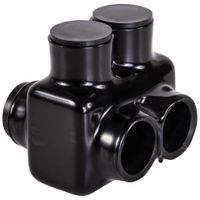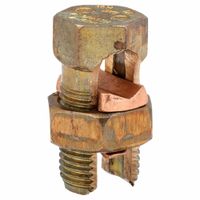Call +(254) 703 030 000 / 751 483 999 / 721 704 777
- Home
- Electrical
- Electrical Connectors Wiring Devices
- Wire Connectors Terminals Terminal Blocks
- Multitap Mechanical Split Bolt Connectors
.....Read More
Frequently Asked Questions
What are the advantages of using multitap wire connectors?
Multitap wire connectors offer several advantages:
1. **Efficiency**: They allow for quick and easy connections of multiple wires without the need for twisting or soldering, saving time during installation.
2. **Versatility**: These connectors can accommodate various wire sizes and types, making them suitable for a wide range of applications, from residential to industrial settings.
3. **Safety**: Multitap connectors provide secure and reliable connections, reducing the risk of loose wires, which can lead to electrical failures or fires.
4. **Space-Saving**: Their compact design allows for efficient use of space within electrical panels or junction boxes, facilitating cleaner and more organized installations.
5. **Reusability**: Many multitap connectors are designed to be reusable, allowing for easy disconnection and reconnection of wires, which is beneficial for maintenance and troubleshooting.
6. **Durability**: Made from robust materials, these connectors are resistant to corrosion and environmental factors, ensuring long-lasting performance.
7. **Cost-Effective**: By reducing installation time and minimizing the need for additional tools or materials, multitap connectors can lower overall project costs.
8. **Reduced Skill Requirement**: They simplify the wiring process, making it accessible to individuals with varying levels of electrical expertise.
9. **Improved Aesthetics**: The neat and tidy connections provided by multitap connectors enhance the visual appeal of electrical installations.
10. **Compliance**: Many multitap connectors meet industry standards and regulations, ensuring safe and compliant electrical systems.
How do you install mechanical lugs on heavy gauge conductors?
1. **Select the Right Lug**: Choose a mechanical lug that matches the conductor size and material. Ensure it is rated for the current and voltage of the application.
2. **Prepare the Conductor**: Strip the insulation from the conductor to expose the bare wire. The length of the exposed wire should match the lug's barrel length. Avoid nicking or damaging the wire strands.
3. **Clean the Conductor**: Use a wire brush to clean the exposed conductor strands. This removes oxidation and ensures a good electrical connection.
4. **Apply Anti-Oxidant Compound**: For aluminum conductors, apply an anti-oxidant compound to the exposed strands to prevent corrosion and improve conductivity.
5. **Insert the Conductor**: Insert the stripped end of the conductor into the lug barrel. Ensure all strands are inside the barrel and none are splayed out.
6. **Tighten the Set Screws**: Use a torque wrench to tighten the lug's set screws. Follow the manufacturer's specified torque values to ensure a secure connection without damaging the conductor.
7. **Inspect the Connection**: Check that the conductor is fully inserted and the screws are properly tightened. Ensure there is no exposed wire beyond the lug barrel.
8. **Secure the Lug**: If the lug has mounting holes, secure it to the busbar or terminal block using appropriate hardware. Ensure a tight and stable connection.
9. **Test the Connection**: Perform a continuity test to ensure a good electrical connection. Check for any signs of overheating or loose connections during operation.
10. **Document the Installation**: Record the installation details, including torque values and any observations, for future reference and maintenance.
What materials are split bolt wire connectors made from?
Split bolt wire connectors are typically made from materials that ensure durability, conductivity, and resistance to environmental factors. The primary materials used include:
1. **Copper**: Copper is the most common material for split bolt connectors due to its excellent electrical conductivity and resistance to corrosion. It is often used in environments where high conductivity is crucial.
2. **Brass**: Brass, an alloy of copper and zinc, is also frequently used. It offers good conductivity and is more cost-effective than pure copper. Brass connectors are suitable for general-purpose applications.
3. **Bronze**: Bronze, an alloy of copper and tin, provides good conductivity and is highly resistant to corrosion, making it suitable for outdoor and marine environments.
4. **Aluminum**: Aluminum split bolt connectors are used for applications where weight is a concern. They are less conductive than copper but are more lightweight and cost-effective.
5. **Tin Plating**: Many split bolt connectors, especially those made from copper or brass, are tin-plated to enhance their corrosion resistance and to prevent oxidation, which can degrade performance over time.
6. **Nickel Plating**: In some cases, nickel plating is used for additional corrosion resistance and to provide a protective barrier against harsh environmental conditions.
These materials are chosen based on the specific requirements of the application, such as the need for high conductivity, resistance to environmental factors, and cost considerations.
Can multitap connectors be used for outdoor applications?
Yes, multitap connectors can be used for outdoor applications, but certain conditions and specifications must be met to ensure their effectiveness and safety. When selecting multitap connectors for outdoor use, consider the following factors:
1. **Weather Resistance**: The connectors should be rated for outdoor use, meaning they must be able to withstand various weather conditions such as rain, snow, and extreme temperatures. Look for connectors with an IP (Ingress Protection) rating that indicates their resistance to dust and water.
2. **Material Durability**: The materials used in the connectors should be corrosion-resistant and durable enough to handle environmental stressors. Common materials include UV-resistant plastics and corrosion-resistant metals like stainless steel or aluminum.
3. **Sealing and Insulation**: Proper sealing is crucial to prevent moisture ingress, which can lead to corrosion and electrical failures. Connectors with robust sealing mechanisms and high-quality insulation materials are essential for maintaining performance in outdoor environments.
4. **Temperature Range**: Ensure the connectors can operate within the temperature range expected in the outdoor setting. Extreme temperatures can affect the performance and longevity of the connectors.
5. **Load Capacity**: The connectors should be capable of handling the electrical load required by the outdoor application. Verify the current and voltage ratings to ensure they meet the demands of the connected devices.
6. **Compliance and Standards**: Check for compliance with relevant industry standards and certifications, such as UL (Underwriters Laboratories) or CSA (Canadian Standards Association), which indicate that the connectors have been tested for safety and performance.
By considering these factors, multitap connectors can be effectively and safely used in outdoor applications, providing reliable electrical connections in various environmental conditions.
How do you choose the right size of split bolt connector for your cables?
To choose the right size of a split bolt connector for your cables, follow these steps:
1. **Identify Cable Size**: Determine the American Wire Gauge (AWG) or circular mils (CM) size of the cables you intend to connect. This information is usually printed on the cable insulation.
2. **Material Compatibility**: Ensure the split bolt material is compatible with the cable material. Use copper split bolts for copper cables and aluminum split bolts for aluminum cables to prevent galvanic corrosion.
3. **Check Manufacturer Specifications**: Refer to the manufacturer's specifications for the split bolt connector. These specifications will list the range of cable sizes that each connector can accommodate.
4. **Consider Combined Conductor Size**: If connecting multiple cables, calculate the combined conductor size. The split bolt must accommodate the total cross-sectional area of all cables being connected.
5. **Review Electrical Code Requirements**: Consult the National Electrical Code (NEC) or local electrical codes for any specific requirements or restrictions regarding split bolt connectors.
6. **Inspect Physical Fit**: Ensure the split bolt connector physically fits the cables without excessive force. The connector should securely hold the cables without damaging the insulation.
7. **Evaluate Current Rating**: Verify that the split bolt connector can handle the current load of the circuit. The connector's current rating should meet or exceed the circuit's requirements.
8. **Consider Environmental Factors**: For outdoor or harsh environments, choose split bolts with appropriate coatings or insulations to prevent corrosion and ensure longevity.
9. **Test for Secure Connection**: After installation, ensure the connection is tight and secure. A properly sized split bolt will maintain a firm grip on the cables without slippage.
By following these steps, you can select the appropriate split bolt connector size for your cables, ensuring a safe and reliable electrical connection.
Are special tools required for installing mechanical wire connectors?
No, special tools are not typically required for installing mechanical wire connectors. Most mechanical wire connectors, such as twist-on wire connectors, push-in connectors, and lever connectors, are designed for ease of use and can be installed using basic hand tools that are commonly found in a standard toolkit. These tools may include:
1. **Wire Strippers**: Used to remove the insulation from the ends of the wires to ensure a proper connection.
2. **Pliers**: Helpful for twisting wires together before applying a twist-on connector, although many connectors are designed to eliminate the need for pre-twisting.
3. **Screwdrivers**: Sometimes needed for securing certain types of connectors, especially those with screw terminals.
4. **Cutters**: Used to trim wires to the appropriate length before connecting.
While these basic tools are generally sufficient, some specific types of connectors or applications might require additional tools. For example, crimp connectors require a crimping tool to secure the connection properly. However, these are not considered mechanical wire connectors in the traditional sense, as they rely on deformation of the connector to secure the wire.
In summary, while basic hand tools are typically sufficient for installing mechanical wire connectors, the specific requirements can vary depending on the type of connector and the application.
What are the safety precautions when using insulated multitap wire connectors?
1. **Read Manufacturer's Instructions**: Always start by reading and understanding the manufacturer's guidelines and specifications for the specific insulated multitap wire connectors you are using.
2. **Inspect Connectors**: Before use, inspect the connectors for any signs of damage, wear, or defects. Do not use connectors that appear compromised.
3. **Use Appropriate Tools**: Utilize the correct tools for cutting, stripping, and crimping wires to avoid damaging the connectors or wires.
4. **Verify Compatibility**: Ensure that the connectors are compatible with the wire gauge and type you are working with. Using incompatible connectors can lead to poor connections and potential hazards.
5. **Turn Off Power**: Always turn off the power supply to the circuit you are working on to prevent electrical shock or short circuits.
6. **Proper Wire Stripping**: Strip wires to the correct length as specified by the connector manufacturer to ensure a secure connection without exposed conductors.
7. **Secure Connections**: Make sure wires are fully inserted and securely fastened within the connector to prevent loose connections, which can cause overheating or arcing.
8. **Avoid Overloading**: Do not exceed the current rating of the connectors. Overloading can lead to overheating and potential fire hazards.
9. **Check Insulation**: Ensure that the insulation on the connectors is intact and not compromised, as this provides protection against electrical shock.
10. **Regular Maintenance**: Periodically check the connections for signs of wear, corrosion, or loosening, especially in environments subject to vibration or temperature fluctuations.
11. **Environmental Considerations**: Use connectors rated for the specific environmental conditions they will be exposed to, such as moisture, temperature extremes, or chemical exposure.
12. **Training and PPE**: Ensure that anyone using the connectors is properly trained and equipped with appropriate personal protective equipment (PPE), such as insulated gloves and safety glasses.


